Click on images to enlarge

infestation (Photo: Sheldon Navie)

habit in flower (Photo: Sheldon Navie)
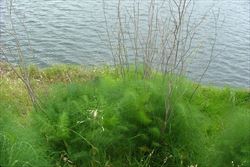
habit with old stems and young growth (Photo: Sheldon Navie)

stems and leaves (Photo: Sheldon Navie)
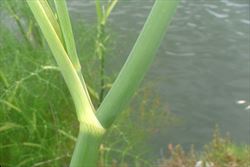
close-up of stem and sheathed leaf base (Photo: Sheldon Navie)
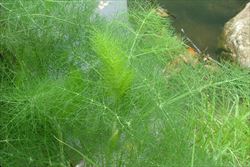
finely-divided fern-like leaves (Photo: Sheldon Navie)
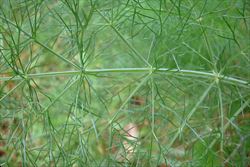
close-up of tiny leaf segments (Photo: Sheldon Navie)

young flower cluster (Photo: Sheldon Navie)

compound flower cluster (Photo: Sheldon Navie)

flowers with inrolled petals (Photo: Sheldon Navie)
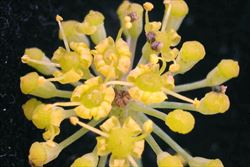
close-up of flowers (Photo: Greg Jordan)
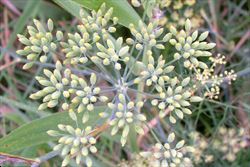
immature fruit (Photo: Sheldon Navie)
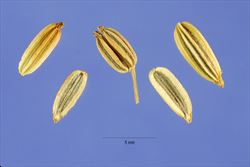
close-up of seeds (Photo: Steve Hurst at USDA PLANTS Database)

young plant (Photo: Sheldon Navie)
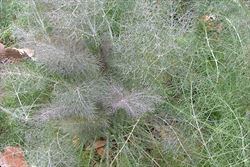
bronze fennel, Foeniculum vulgare var. rubrum (Photo: Sheldon Navie)
Scientific Name
Foeniculum vulgare Mill.
Synonyms
Foeniculum officinale All.
Family
Apiaceae (Queensland, New South Wales, the ACT, Victoria, Tasmania, Western Australia and the Northern Territory)Umbelliferae (South Australia)
Common Names
anise, aniseed, aniseed weed, dill, false aniseed, false dill, fennel, sweet anise, sweet fennel, wild fennel
Origin
This species originated in southern Europe (i.e. France, Portugal, Spain, Albania, Bulgaria, Greece, Italy and Yugoslavia), the Azores, the Madeira Islands, the Canary Islands, northern Africa (i.e. Algeria, Egypt, Libya, Morocco and Tunisia) and western Asia.
Cultivation
Fennel (Foeniculum vulgare ) has long been cultivated as a vegetable and as a source of other culinary and medicinal products. There are several varieties and cultivars. For example, a reddish-leaved form known as bronze fennel (Foeniculum vulgare 'Purpureum' or Foeniculum vulgare var. rubrum).
Naturalised Distribution
A widespread species that is naturalised mainly in the coastal and sub-coastal districts throughout the southern and south-eastern parts of Australia. It is most common in Victoria, eastern New South Wales, the ACT, Tasmania, south-eastern South Australia and south-western Western Australia. Also occasionally naturalised in some inland parts of eastern South Australia and northern New South Wales, in the cooler districts of south-eastern Queensland, and on Norfolk Island.
Widely naturalised overseas in the UK, southern Africa, New Zealand, the Pacific (i.e. Hawaii, Fiji, New Caledonia, Niue and French Polynesia), the USA, Mexico, Central America and South America.
Habitat
A weed of roadsides, railways, gardens, waterways, wetlands, riparian zones, drains, open woodlands, pastures, grasslands, disturbed sites and waste areas in temperate, and occasionally also sub-tropical or semi-arid, environments.
Habit
An upright (i.e. erect) and long-lived (i.e. perennial) herbaceous plant with branching stems usually growing 1.5-2 m tall, but sometimes reaching up to 3 m in height.
Distinguishing Features
- a large, long-lived, herbaceous plant forming large clumps up to 2 m tall.
- it produces numerous short-lived upright stems from a long-lived crown.
- its alternately arranged leaves are finely divided into many thread-like segments and have a ferny appearance.
- its tiny yellow flowers are borne in large flat clusters at the tips of the branches.
- its leaves gives off a strong aniseed-like smell when handled or crushed.
Stems and Leaves
The upright (i.e. erect) stems are quite robust (often more than 10 mm thick) and filled with a white spongy pith. They are green or somewhat bluish-green in colour, but not very long-lived (i.e. annual), and turn brown as they die off. These stems are hairless (i.e. glabrous), usually have fine lengthwise ridges (i.e. they are striate), and have very obvious joints (i.e. nodes).
The bright green leaves (30-50 cm long) are alternately arranged along the stems and form rosette-like clumps at the base of the plant. They are highly divided (i.e. pinnatisect) into numerous tiny segments that give them a 'ferny' appearance. Each of the tiny segments is thread-like (i.e. filiform) in nature (up to 40 mm or more long and about 0.5 mm wide). The leaves are hairless (i.e. glabrous) and are borne on hollow stalks (i.e. petioles) which sheath the stem at the base.
Flowers and Fruit
The tiny yellow flowers (1-3 mm across) are borne in large, flattened clusters (7-15 cm across) at the tops of the branches (i.e. in terminal compound umbels). These flower clusters are borne on stalks (i.e. peduncles) up to 12 cm long and are made up of several (6-30) smaller clusters (i.e. umbels) of 10-30 flowers. Each of the smaller clusters (5-15 mm across) has its own stalk up to 6 cm long and the individual flowers are borne on even smaller stalks (i.e. pedicels) 1-7 mm long. Individual flowers have five yellow petals that are strongly inrolled. They also have five stamens and a tiny ovary topped with two styles. Flowering occurs during spring and summer (i.e. from September to December).
The fruit turn from green to grey, brown or yellowish-brown as they mature. These fruit (4-10.5 mm long) are somewhat egg-shaped (i.e. ovoid-oblong) and consist of two 'seeds' (i.e. mericarps) that separate from each other at maturity. Each of these 'seeds' (3-6 mm long and 1.5-2 mm wide) has five prominent ribs.
Reproduction and Dispersal
This species reproduces mostly by seed, but is also capable of re-growing from pieces of its long-lived (i.e. perennial) crown.
Seeds are dispersed by water, vehicles, machinery and animals, or in mud, contaminated agricultural produce and dumped garden waste. Pieces of the crown may also be spread by machinery, cultivation or in dumped garden waste.
Environmental Impact
Fennel (Foeniculum vulgare) is a significant and widespread environmental weed, particularly in south-eastern Australia, and is listed as a priority environmental weed in at least one Natural Resource Management region. It is regarded as an environmental weed in Tasmania, the ACT, South Australia, New South Wales, Western Australia and the cooler districts of south-eastern Queensland, but is probably of most concern in Victoria.
This species can form very dense infestations that crowd out other vegetation. It is able to out-compete small native understorey shrubs and groundcover plants and is likely to reduce the amount of useful habitat available to native animals. It is of most concern along waterways and in wetlands, but can also affect remnant native vegetation in farming areas. Fennel (Foeniculum vulgare) has also invaded numerous conservation areas in south-eastern Australia and is considered to be a potential threat to the last remaining population of the critically endangered Sunshine diuris (Diuris fragrantissima).
Other Impacts
Fennel (Foeniculum vulgare) may occasionally also invade agricultural areas, particularly degraded pastures. However, it is palatable to livestock and is generally not seen as a major problem in these areas.
Legislation
This species is declared under legislation in the following states and territories:
- Victoria: C5 - a regionally controlled weed in the Glenelg, Corangamite, Port Phillip East, West Gippsland and East Gippsland regions, where landholders must take all reasonable steps to control it and prevent its spread on their land and the roadsides which adjoin their land.
- Tasmania: D - the importation or sale of this species is prohibited and measures to reduce its population in an area, eradicate it from an area, or restrict it to a particular area may be required.
- Western Australia: Unassessed - this species is declared in other states or territories and is prohibited until assessed via a weed risk assessment (throughout the entire state).
Management
For information on the management of this species see the following resources:
- the Tamar Valley Weed Strategy information page on this species, which is available online at http://www.weeds.asn.au.
- Muyt (2001), Bush Invaders of South-east Australia, pp. 106-107.
Similar Species
Fennel (Foeniculum vulgare) may sometimes be confused with water parsnip (Berula erecta), hemlock (Conium maculatum), Bishop's weed (Ammi majus), coriander (Coriandrum sativum), wild carrot (Daucus carota) and celery (Apium graveolens). These species can be distinguished by the following differences:
- fennel (Foeniculum vulgare) does not have spotted stems and gives off a strong smell when its very finely divided leaves are crushed. Its large compound clusters of flowers are made up of several to numerous (8-30) smaller clusters of tiny flowers (i.e. the inflorescence is a compound umbel). These flowers are yellow in colour and their inrolled petals are roughly all the same size. It produces slightly elongated (i.e. ovoid or oblong) fruit that are prominently ribbed.
- water parsnip (Berula erecta) does not have spotted stems and does not give off a strong smell when its leaves are crushed. Its large compound clusters of flowers are made up of several to numerous (6-30) smaller clusters of tiny flowers (i.e. the inflorescence is a compound umbel). These flowers are white in colour and their petals are roughly all the same size. It produces slightly elongated (i.e. ovoid or ellipsoid) fruit that are prominently ribbed.
- hemlock (Conium maculatum) has purplish spotted stems and gives off a strong smell when its leaves are crushed. Its large compound clusters of flowers are made up of several (6-20) smaller clusters of tiny flowers (i.e. the inflorescence is a compound umbel). These flowers are white in colour and their incurved petals are roughly all the same size. It produces slightly elongated (i.e. ovoid or ellipsoid) fruit that are prominently ribbed.
- Bishop's weed (Ammi majus) does not have spotted stems and does not give off a strong smell when its leaves are crushed. Its large compound clusters of flowers are made up of numerous (20-40) smaller clusters of tiny flowers (i.e. the inflorescence is a compound umbel). These flowers are white in colour and their petals are roughly all the same size. It produces slightly elongated (i.e. ovoid or ellipsoid) fruit that are prominently ribbed.
- coriander (Coriandrum sativum) does not have spotted stems and gives off a strong smell when its leaves are crushed. Its large compound clusters of flowers are made up of a few (3-8) smaller clusters of flowers (i.e. the inflorescence is a compound umbel). These flowers are either pale pink, mauve or white in colour and their petals vary in size (i.e. the outwards facing petals of the outer flowers of each small cluster are much larger). It produces almost rounded (i.e. sub-globular) fruit that are only slightly ribbed.
- wild carrot (Daucus carota) does not have spotted stems and does not give off a strong smell when its leaves are crushed. Its large compound clusters of flowers are made up of numerous (30-60) smaller clusters of flowers (i.e. the inflorescence is a compound umbel). These flowers are mostly white in colour, however the central flower of each cluster is pink, red or purplish in colour, and their petals vary in size (i.e. the outwards facing petals of the outer flowers of each small cluster are often much larger). It produces slightly elongated (i.e. ovoid or ellipsoid) ribbed fruit that are covered with bristles.
- celery (Apium graveolens) does not have spotted stems and gives off a strong smell when its leaves are crushed. Its large compound clusters of flowers are made up of few to several (4-16) smaller clusters of tiny flowers (i.e. the inflorescence is a compound umbel). These flowers are white in colour and their petals are roughly all the same size. It produces almost rounded (i.e. sub-globular) or slightly elongated (i.e. broadly ovoid) fruit that are only slightly ribbed.
Fennel (Foeniculum vulgare) is also relatively similar to milfoil (Achillea millefolium ), particularly when in the vegetative stage of growth. But the latter species usually produces clusters of larger pink or white flowers (5-10 mm across).

